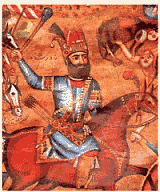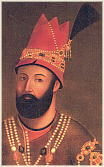In 1719 the Afghans had invaded Persia. They deposed the reigning Shah of the Safavid dynasty in 1722. Their ruler, Mahmud Ghilzai (±1699-1725), murdered a large number of Safavid Princes, hacking many of them to death by his own hand. After he had invited the leading citizens of Isfahan to a feast and massacred them there, his own supporters assassinated Mahmud in 1725. His cousin, Ashraf (±1700-1730), took over and married a Safavid princess.
At first, Nadir fought with the Afghans against the Özbegs until they withheld him further payment. In 1727 Nadir offered his services to Tamasp II (±1704-1740), heir to the Safavid dynasty. Nadir started the reconquest of Persia and drove the Afghans out of Khurasan. The Afghans suffered heavy losses, but before they fled Ashraf massacred an additional 3000 citizens of Isfahan. Most of the fleeing Afghans were soon overtaken and killed by Nadir's men, while others died in the desert. Ashraf himself was hunted down and murdered.

By 1729, Nadir (to the right) had freed Persia from the Afghans. Tamasp II was crowned Shah, although he was little more than a figurehead. While Nadir was putting down a revolt in Khurasan, Tamasp moved against the Turks, losing Georgia and Armenia. Enraged, Nadir deposed Tamasp in 1732 and installed Tamasp's infant son, Abbas III (1732-1740), on the throne, naming himself regent. Within two years Nadir recaptured the lost territory and extended the Empire at the expense of the Turks and the Russians.
In 1736, Nadir evidently felt that his own position had been established so firmly that he no longer needed to hide behind a nominal Safavid Shah and ascended the throne himself. In 1738 he invaded Qandahar, captured Kabul and marched on to India. He seized and sacked Delhi and, after some disturbances, he killed 30000 of its citizens. He plundered the Indian treasures of the Mughal Emperors, taking with him the famous jewel-encrusted Peacock Throne and the Koh-i Noor diamond2. In 1740 Nadir had Tamasp II and his two infant sons put to death. Then he invaded Transoxania. He resumed war with Turkey in 1743. In addition, he built a navy and conquered Oman.
Gradually Nadir's greedy and intolerant nature became more pronounced. The financial burden of his standing armies was more than the Persians could bear and Nadir imposed the death penalty on those who failed to pay his taxes. He stored most of his loot for his own use and showed little if any concern for the general welfare of the country. Nadir concentrated all power in his own hands. He was a brilliant soldier and the founder of the Persian navy, but he was entirely lacking any interest in art and literature. Once, when Nadir was told that there was no war in paradise, he was reported to have asked: "How can there be any delights there?". He moved the capital to Mashhad in Khurasan, close to his favourite mountain fortress. He tried to reconcile Sunnism with Shi'itism, because he needed people of both faiths in his army, but the reconciliation failed.
In the evening Nadir would retire to his private apartment, where he usually supped with three or four favourites. He drank wine with moderation, but was very fond of women. In his later days, Nadir had 33 women in his harem.
In his later years, revolts began to break out against Nadir's oppressive rule and his increasing lust for blood and money. He suffered from dropsy, and as a result he was troubled at times by severe melancholia and outbursts of rage. In 1743 Nadir was treated for a liver complaint. In the summer of 1745 he was seriously ill and had to be carried in a litter. He suffered from constipation and had frequent attacks of vomiting.
 Following an assination attempt, Nadir (to the right) began exhibited signs of mental derangement. He suspected his own son, Reza Quli Mirza (1719-1747), of plotting against him and had him blinded. Soon he started executing the nobles who had witnessed his son's blinding.
Gradually Nadir's attacks of frenzy became periods of actual insanity which recurred with increasing frequency. In January 1747 he left Isfahan for Kirman. Wherever he halted, Nadir had many people tortured and put to death. He had towers of their heads erected. In March he crossed the terrible Dasht-i-Lut desert, where many of his men perished of hunger and thirst. By then, even his own tribesmen felt that he was too dangerous a man to be near. A group of Afshar and Qajar chiefs decided "to breakfast off him ere he should sup off them".
Following an assination attempt, Nadir (to the right) began exhibited signs of mental derangement. He suspected his own son, Reza Quli Mirza (1719-1747), of plotting against him and had him blinded. Soon he started executing the nobles who had witnessed his son's blinding.
Gradually Nadir's attacks of frenzy became periods of actual insanity which recurred with increasing frequency. In January 1747 he left Isfahan for Kirman. Wherever he halted, Nadir had many people tortured and put to death. He had towers of their heads erected. In March he crossed the terrible Dasht-i-Lut desert, where many of his men perished of hunger and thirst. By then, even his own tribesmen felt that he was too dangerous a man to be near. A group of Afshar and Qajar chiefs decided "to breakfast off him ere he should sup off them".Nadir was Persia's most gifted military genius and is known as "The Second Alexander" and "The Napoleon of Persia". He raised his country from the lowest depths of degradation to the proud position of the foremost military power in Asia. Unfortunately, his triumphs were at the expense of incalculable suffering and terrible loss of life. His grandiosity, his insatiable desire for more conquests and his egocentric behaviour suggest a narcissistic personality disorder and in his last years he seems to have developed some paranoid tendencies. Nadir was married four times and had 5 sons and 15 grandsons. Their deaths were ordered by Nadir's successor.